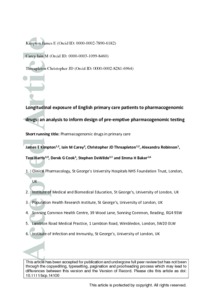Kimpton, JE; Carey, IM; Threapleton, CJD; Robinson, A; Harris, T; Cook, DG; DeWilde, S; Baker, EH
(2020)
Longitudinal exposure of English primary care patients to pharmacogenomic drugs: An analysis to inform design of pre‐emptive pharmacogenomic testing.
Br J Clin Pharmacol, 85 (12).
pp. 2734-2746.
ISSN 1365-2125
https://doi.org/10.1111/bcp.14100
SGUL Authors: Carey, Iain Miller
![[img]](https://openaccess.sgul.ac.uk/111124/1.hassmallThumbnailVersion/Kimpton%20BJCP%202019%20Accepted%20Version.pdf)  Preview |
|
PDF
Accepted Version
Available under License ["licenses_description_publisher" not defined].
Download (977kB)
| Preview
|
Abstract
Aims
To investigate the longitudinal exposure of English primary care patients to pharmacogenomic drugs to inform design of pre‐emptive testing.
Methods
Sixty‐three drugs were identified with dosing guidelines based on variants of 19 pharmacogenes in the Pharmacogenomics Knowledgebase on 01 September 2018. Prescribing of these pharmacogenomic drugs between 1993 and 2017 was summarised for a sample of 648 141 English patients aged 50–99 years on 01 January 2013, registered with Clinical Practice Research Datalink practices during 2011–12. Exposure of patients to pharmacogenomic drugs retrospectively (2, 10, 20 y) and prospectively (5 y) was described.
Results
During 2011–12, 58% of patients were prescribed at least 1 pharmacogenomic drug, increasing to 80% over the previous 20 years. Multiple exposure was common, with 47% patients prescribed ≥2 pharmacogenomic drugs and 7% prescribed ≥5 pharmacogenomic drugs over the next 5 years. The likelihood of exposure to pharmacogenomic drugs increased with age, with 89% patients ≥70 years prescribed at least 1 pharmacogenomic drug over the previous 20 years. Even among those aged 50–59 years, 71% were prescribed at least 1 pharmacogenomic drug over the previous 20 years. The pharmacogenomic drugs prescribed to the most patients were for pain relief, gastroprotection, psychiatric and cardiovascular conditions. Three pharmacogenes (CYP2D6, CYP2C19 and SLCO1B1) accounted for >95% pharmacogenomic drugs prescribed.
Conclusions
In primary care patients, exposure to pharmacogenomic drugs is extremely common, multiplicitous and has commenced by relatively early adulthood. A small number of pharmacogenes account for the majority of drugs prescribed. These findings could inform design of pre‐emptive pharmacogenomic testing for implementation in primary care.
Statistics
Item downloaded times since 28 Aug 2019.
Actions (login required)
 |
Edit Item |



